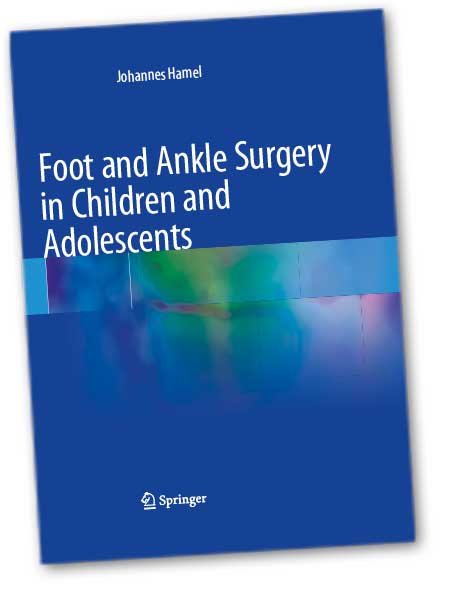Prof. Dr. med. Johannes Hamel
Facharzt für Orthopädie und Unfallchirurgie
Kinderorthopädie / Rheumatologie
Summary of „Foot and Ankle Surgery in Children and Adolescents“
Chapter 1: The Idiopathic Clubfoot
The pathological anatomical features of idiopathic clubfoot are presented by means of sonographic examination of special regions of interest. Clinical and imaging diagnostic tools and their practical use are described in detail. The Ponseti primary treatment concept is illustrated with several clinical examples including observation of tarsal alignment with the sonographic technique invented by the author. Surgical options and indications for primary treatment, relapse and overcorrection surgery are presented with X-ray analysis of many clinical examples of children and adolescents. Pedographic examination is used freqently to take into accout also functional aspects. The Tanzanian experience of the author in the treatment of neglected clubfeet of all ages is included. Special emphasis is layed on the tibiotalar joint for longterm prognosis of idiopathic clubfoot.
Chapter 2: Skew foot / Serpentine foot
The pathological anatomy of skew foot at the tarsometatarsal region, radiologic aspects, spontaneous course of the deformity and indication for conservative or surgical treatment are discussed in detail. For preschool- and school-age combined osteotomies of the medial cuneiform bone and the proximal metatarsal region of the second to fifth ray proved to be a safe and effective option. In milder cases of serpentine foot the hindfoot complex often has not to be adressed seperately, however severe eversion deformity requires additional hindfoot stabilization.
Chapter 3: Talus verticalis (Vertical talus)
This complex deformity with its high risk for relapse is displayed with several surgical treated cases that were observed for longer periods. The modern „reversed Ponseti“-treatment is presented as a valuable option at least for milder cases.
Chapter 4: The flexible planovalgus foot
Extensive important propaedeutic considerations for evaluation and treatment indication of this frequent pediatric entity are put in front of the detailed presentation of an algorithm for surgical options. The pathomorphology, clinical presentation, spontaneous course, late prognosis, standardized radiologic and pedographic evaluation are taken into account thoroughly. The radiologic TMT-Index invented by the author provides a useful tool to quantitatively evaluate planovalgus deformity. Techniques following the principles of guided growth (arthrorisis) are presented as minimally invasive solutions for the late growing age with many treatment examples. For adolescence three-dimensional correction can be achieved best by tarsal triple osteotomy (TTO), invented by the author as a routine procedure and has proven to be superior to a single osteotomy approach. An intermediate group may be treated successfully by an arthrorisis osteotomy combination (AOC). Selected fusions of the tarsometatarsal region are indicated for severe hypermobility.
Chapter 5: Tarsal coalitions and rigid planovalgus deformity
The author‘s experience with several hundreds of surgically treated tarsal coalitions in children and adolescents are summarized with many treatment examples. Modern diagnostic tools like CT and DVT are helpful not only for diagnosis but especially for differential indication for coalition resection versus primary fusion. Resection techniques including interposition of fat tissue or muscle are described in detail as well as fusion techniques indicated sometimes even in younger patients. In rigid planovalgus deformity a one stage procedure with resection and deformity correction is recommended to improve tarsal alignment and function.
Chapter 6: Neurogenic deformities
The principles of foot and ankle deformities developing from muscular dysbalance of different origin (excluded neurogenic cavovarus deformity) are illustrated by an example of a severe hemiplegic equinocavovarus malalignment. Muscle-tendon lengthening procedures, tendon transfer, deformity correction and stabilization by hindfoot fusions are discussed for spastic and flaccid cases of equinus, equinovarus, equinoplanovalgus.
Chapter 7: Cavovarus deformity
Pathogenesis and biomechanical aspects of the neurogenic cavovarus deformity observed most frequently in hereditary sensomotoric neuropathy are described in detail. The hindfoot-centered X-ray technique described by the author provides important information for treatment planning and evaluation of treatment effects. The principles of surgical correction by soft-tissue release, tendon transfer and osteotomies are presented as well as the Cole procedure, Chopart-fusion, Lambrinudi modification of triple fusion and supramalleolar correction of malrotation for more advanced cases. Correction of claw toes also is an essential part of the treatment concept. Several clinical cases are discussed in detail. Pedographical observations are extremely useful to document functional deterioration in children and adolescents and for outcome-measurement.
Chapter 8: Supramalleolar deformities
Growth disturbances of the supramalleolar region are observed in different conditions like multiple cartilaginous exostoses, epiphyseal osteonecrosis, neurofibromatosis, clubfoot (especially overcorrected cases), posttraumatic disorders and others. Techniques of hemiepiphyseodesis and supramalleolar correction taking into consideration the rules of CORA are presented. The Wiltse technique has proven to be effective especially for severe valgus deformity.
Chapter 9: Osteochondral lesion of the talus
Surgical treatment of talar osteochondral lesions is rarely necessary in early childhood but may be considered more frequently in adolescence. Among different treatment options the extended medial malleolar osteotomy with careful debridement of the defect, insertion of cancellous bone and application of an AMIC-membrane is a proven option with good results in most cases.
Chapter 10: Middle-forefoot deformities in children
Surgical treatment may be considered for different deformities and malformations of the middle-forefoot region. Typical solutions are presented for iuvenile hallux valgus syndrome with scarf osteotomy as the recommended standard procedure, interphalangeal deformity correction and for congenital hallux varus with long epiphyseal bracket. Butler release is described in detail for the overriding fifth toe. Entities like Koehler disease, polydactylism, macrodactylism, brachymetatarsia and metatarsal synostosis are added with some clinical examples.
